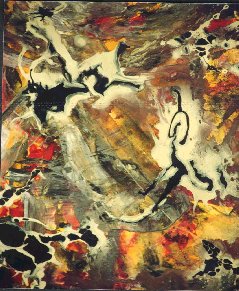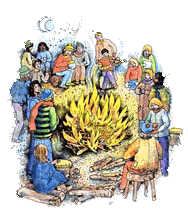|
Living the Cecropian Still-Life: Transforming The Human Relationship to The Wild Through Spontaneous Painting By L. M. Lipsett |
 |
"To understand the human role in the functioning of the Earth we need to appreciate the spontaneities found in every form of existence in the natural world, spontaneities that we associate with the wild- that which is uncontrolled by human dominance. We misconceive our role if we consider that our historical mission is to "civilize" or "domesticate" the planet, as though wildness is something destructive rather than the ultimate creative modality of any form of earthly being. We are not here to control. We are here to become integral with the larger Earth community. The community itself and each of its members has ultimately a wild component, a creative spontaneity that is its deepest reality, its most profound mystery". The journey that currently fascinates me is the one experienced by myself and other painters as we learn to re-connect to the wild in ourselves. I am especially interested in how a relationship with the wild self can be maintained and nurtured without resorting to attempts to control or confine its power. Cecropian moths metamorph or transform themselves from caterpillar to moth through a mysterious and complex process that continues to enchant scientists. I too have become enchanted with this self-change process as I transform myself through engaging in spontaneous painting. I did not choose the metaphor of Cecropian moth metamorphosis for this work, rather it chose me.
Spontaneous painting is a form of self-transformation or metamorphosis. Work of this nature is essential for the sustainable transformation of the human-earth relationship. It animates our own inherent wildness thus dissolving the boundary between the human and the wilderness. Further it enlivens, enchants and enfolds us in a timeless state where we can experience the creative spark that binds all living beings. I did not set out or plan to paint the images I am sharing in this piece. For me, spontaneous painting is about experiencing and nurturing the wild. This kind of painting is organic in nature since nothing is planned before hand. It is a free flowing dance between my body-mind, the wilderness and the paint. The Gage Canadian Dictionary defines spontaneous as "growing or produced naturally; not planted or cultivated- caused by natural impulse or desire, not forced compelled, not planned beforehand". What I do is also natural. I set up the materials and let what is meant to happen that day, take place as best as it can. I cultivate the soil and then get out of the way as the seeds sprout on the page in the form of watery strokes. I close my eyes to choose the colours blindly and I do the same for the brush. Then I open my eyes and let my hand and the brush move the paint around the page at will. I need to be "present" in order to sense when the chosen colour is finished so that the next colour can be chosen blindly and applied spontaneously. I try to "let go" to the process and see where the paints will take me. When I feel the painting is finished I record how I've been feeling that day, the order in which the colours came up, any reactions I had to the colours or forms created, and then often a poem emerges around some noted aspect of the painting. The poem is free associative in nature and often provides deeper insights and wisdom. Often it initiates a dialogue between myself and the painted colours and forms. The resulting work is a natural or wild creation that gives colour and form to the life force present during that session. The process of painting allows me to experience a sense of timelessness and universal connection while giving life-breath to aspects of my uniqueness. The product of painting: a form, a colour, a texture or a particular combination of the three is like a record of the journey at this time. Images recur and new ones emerge. While creating spontaneously there is no concern for the product created. The goal is to remain mindfully absorbed and to let go the need to arrive at the finished product. If attention is focused on attempting to control or predict the finished product then the contemplative state is temporarily lost. Therefore there is a "being in the universe" aspect to spontaneous painting that nourishes the transformation of the human-earth relationship. I have begun to story both my self and the universe in which I live. By creating without rationality, criticism or an eye fixed on the quality of the end product, I have been able to enter a rich dialogue between myself and the universe. Often we become as one and it is unclear whether I am in the universe or the universe is in me. Both sensations are present simultaneously.
Image creation is a process that captures my mind, heart and soul. It has shifted my self image to include all life forms as I see my reflection in painted clouds, oceans, birds, sunbursts, stars, grass, trees, mud and most recently moths. Traditionally, in creative work of this nature, images are often placed in the service of the dreamer/artist much like life on the planet has been enslaved by the human. Therefore I avoid analyzing the images for meaning. Instead, I interact with the images and experience them as living beings in their own right. By experiencing images in this way I can begin the long journey back to re-energizing my own deep connection to all beings. As a result I have discovered that painted images have stories to tell. As a group, the following four paintings seem to capture the wild creative moment between stillness and life. Like the metamorphosis of a caterpillar to a moth, or the creation of a spontaneous painting, there is a flurry of activity that does not happen systematically from the head to the abdomen. It's a simultaneous creation of the whole. It's characterized by a complete dissolving down of the caterpillar followed by an all-at-once, co-creative coming together of the moth. All of this is happening in the context of cocoon-like outward silence and stillness. I've been exploring the words "still-life" and find they speak to me in many ways. A cocoon looks still and dead on the outside yet inside there is incredible movement and creativity. Traditionally in the art world, a still life involves painting or drawing carefully arranged plants, furniture, tea cups and dead animals. Like pinned butterflies, these renderings capture beautiful objects in an arrangement. In contrast I see my spontaneous painting process as being one where I still myself in order to feel the motion, the wildness of life in that instant. Once finished I emerge with a still painting that is full of life. |
Cecropian Still-life
|
|
Through spontaneous painting I am able to create a sense of internal spaciousness while at the same time experiencing a deeper connection to my place in the wild. I can be in nature in a deeper more sustainable way. I don't need to take it in, acquire it, or co-opt it. I can move like a watery fluid between myself and the wild. I am becoming wilder and more balanced as a result. Finally, I can now embrace a transformed sense of stillness in life and life in the stillness. I can live life in the cecropian dream.
Cecropian dreams References Berry, T. (1999) "The Wild and the Sacred" in The Great Work New York: Random House. Griffin, S. (1978). Woman and Nature: The Roaring Inside Her. New York: Harper & Row. |





